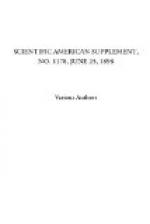This same rule, although to a less extent, applies to the operating and general expense cost, that is, the cost other than interest. To particularize, the manager’s salary and other administrative expenses do not increase in proportion to maximum output of station; therefore, the cost of administration per unit of output, if the business is in a healthy condition, must be from year to year reduced. There are a great many other expenses that are not directly in proportion to output, and these follow the same rule. In a well-run plant the percentage of operating expenses to gross receipts will stand even year after year, while the income per unit of output will be constantly reduced. This is an excellent evidence of the fact that the cost per unit of output is constantly being reduced, as, if it were not, the percentage of expenses to gross receipts would be increased in direct proportion to the reduction in price. Moreover, it should be borne in mind that there are many difficulties in the way of universal use of electric energy from a central station system. It is the rare exception to find a house not piped for gas and water. In the case of the latter it is almost invariably the rule that owners are compelled to pipe for water, under the sanitary code of the municipality. On the other hand, in a large residential district, it is the exception to find a house wired for electric light; consequently the output of current per foot of conductor is at the present time very low as compared with the output of gas per foot of gas pipe in any of the large cities. The expense of wiring (which must of necessity be borne by the householder) is large, and it is often a barrier to the adoption of electric illumination, but as the rule to wire houses becomes more general, the output per foot of main will constantly increase, and therefore the interest per unit of output per foot of main will constantly decrease. This same rule will apply in the case of expenses of taking care of and repairing the distribution system, although to not so great an extent.
If you will take into account these various factors constantly operating toward a reduction of operating and general expense cost, and interest cost, the conclusion must necessarily be forced upon you that the price at which current can be sold at a profit to-day is in no sense a measure of the income per unit which it will be necessary for central station managers to obtain in the future. In 1881-82 it was difficult to make both ends meet with an income of 25 cents per kilowatt hour, to-day there are many stations showing a substantial return on their investment whose average income does not exceed 7 cents per kilowatt hour, showing 70 per cent. reduction in price in less than two decades. How far this constant reduction in cost, followed by a constant reduction in selling price, will go, it is difficult to determine; but if so much has been accomplished during the first 20 years of the existence of the industry, is it too




